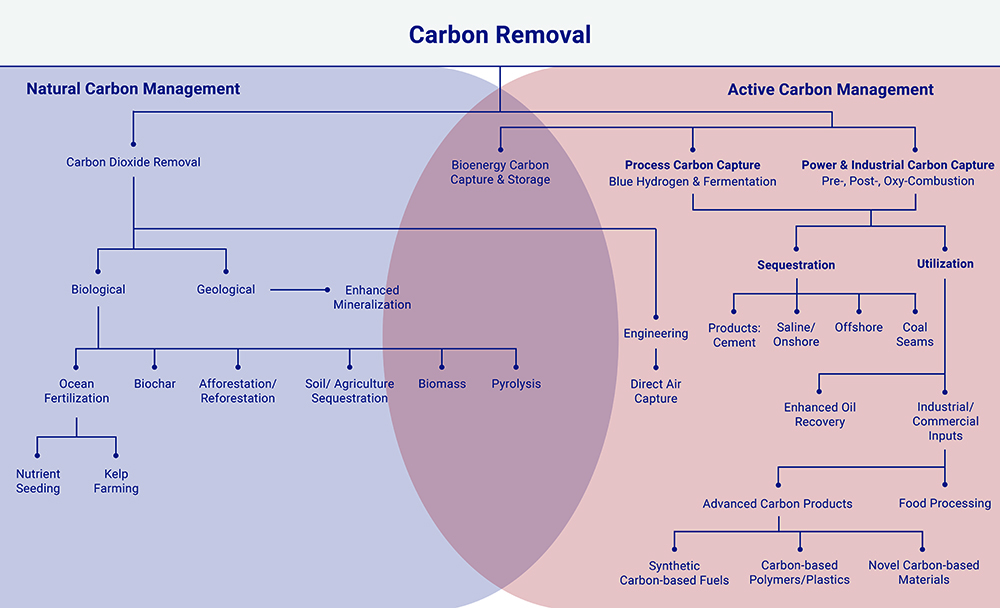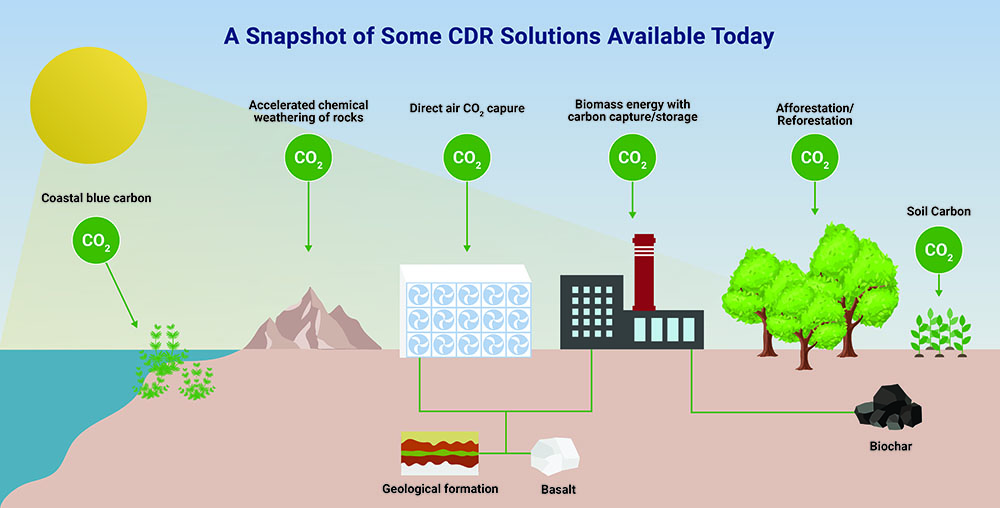Carbon dioxide removal (CDR) refers to technologies, practices and approaches that remove carbon dioxide (CO2) from the atmosphere. CDR does not refer to point-source carbon capture from the power or industrial sector. Though plants, like trees, have been absorbing CO2 for millions of years, and this is where carbon removal efforts have been focused in the past, the CDR space has evolved beyond tree planting. CDR solutions now encompass a wide range of solutions, including natural solutions such as afforestation and soil carbon sequestration, engineered methods such as direct air capture (DAC), and hybrid solutions such as biomass carbon removal and storage (BiCRS) and enhanced rock weathering (ERW), that combine natural and engineered technologies. Many of these CDR solutions are still in their nascent stages of development — therefore, the supply of engineered and hybrid CDR is currently low.
In their most recent report, the IPCC notes that CDR technologies are necessary to avoid the worst effects of changes in our climate, and World Resources Institute estimates that for the U.S., this equates to capturing 2 gigatons annually by 2050. In modeling performed by the International Energy Agency (IEA), DAC technologies alone would need to capture more than 85 million metric tons of CO2 by 2030 and around 980 million metric tons by 2050, a steep scale-up from the 10,000 metric ton capture capacity of DAC today. Furthermore, estimates show that total global CDR capacity needs to reach 10 gigatons of CO2 annually by mid-century and continued increased removal capacity up to 20 gigatons per year by 2100.
Continue Research, Development and Demonstration It is essential that continuous research, development and demonstration (R&D) of diverse CDR solutions occur. Various DOE offices, the U.S. Department of Agriculture (USDA), and carbon removal companies have been actively investing in new types of CDR technologies to deploy at scale. These investments have historically assisted lab-scale research or fuel creation through biomass utilization. Beyond DAC, novel, innovative CDR technologies are increasing in their technology readiness level for demonstration and deployment. Broadening R&D focus areas and increasing the scale of research projects will allow for the maturation of a diverse set of scalable, efficient and economic carbon removal solutions.
Increased Coordination Between Federal Agencies Interagency and interoffice coordination can ensure clear, effective and streamlined R&D and commercialization of CDR technologies. Due to its cross-cutting nature, CDR exists in various different forms, from terrestrial to ocean CDR. There are various offices across DOE and other federal agencies, such as the USDA, Department of Defense (DOD) and the National Oceanic and Atmospheric Administration (NOAA), with valuable expertise and research projects in CDR. Therefore collaboration and information sharing between agencies such as NOAA, which specializes in marine activities, and the Advanced Research Projects Agency–Energy (ARPA-E), which has researched cutting-edge ocean-based carbon removal projects, would foster a unified effort and avoid redundancy.

Source: Adapted from the ITIF Active Carbon Management: Critical Tools in the Climate Toolbox
Build Robust Competitive Purchasing Programs Federal CDR purchasing programs, sometimes called advanced market commitments, are a significant opportunity for the federal government to improve its own CDR investment efforts by accelerating a portfolio of cutting-edge carbon removal solutions. The federal government has already opened the door for DAC companies to benefit from removing and storing carbon dioxide through the 45Q tax credit. Thoughtful public sector purchasing of diverse CDR solutions would drive down the cost of best-in-class technologies that are far too expensive to go to the commercial market in their current form. Many tech companies have started making their own purchases and investments, but even for large companies like Microsoft, CDR technologies are too expensive to invest heavily in a meaningful way that would drive down costs. The federal government could reduce this risk by serving as a customer of CDR technologies that buyers are seeking but are not able to purchase due to cost or lack of supply.
Build low-cost, credible solutions Bolstering CDR solutions by supporting new technologies coming to the market and strengthening confidence in natural carbon removal solutions will further help to develop new technologies. Currently, there is a small set of solutions that are performing well in the market today with the potential for full market commercialization. Solutions, including Charm Industrial’s biomass to bio-oil solution and Occidental’s partnership with Carbon Engineering to build the largest DAC facility in the world, would both permanently sequester significant tons of carbon dioxide. However, both of these solutions have one thing in common: they are currently too expensive to be efficient on a per-ton basis. Therefore, supporting these technologies through tax incentives, loan programs, competitive grants and advanced market commitments is important.
Over the last several years, significant foundational work has set up the success of carbon removal technologies, including the following:

Source: Adapted from theThe National Academies of Sciences, Engineering, and Medicine (NASEM) report on Negative Emissions Technologies and Reliable Sequestration A Research Agenda.
